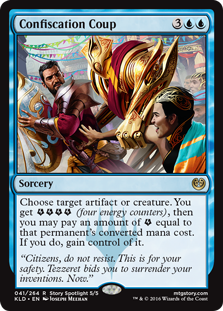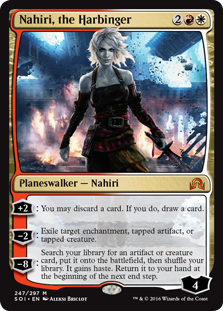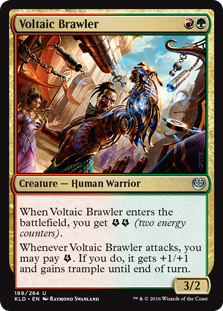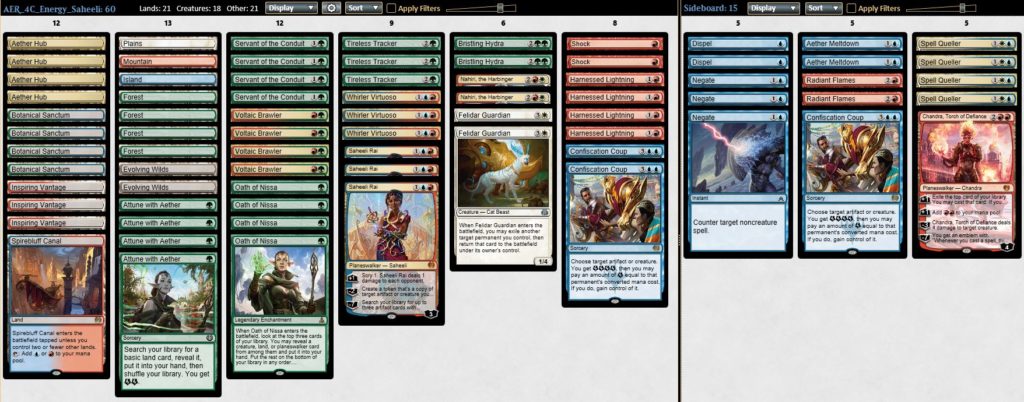I made some predictions about the standard format before SCG Columbus. I have to admit that I got it completely wrong with respect to GB. I didn’t think midrange decks had the tools to deal with combo decks but I completely missed Walking Ballista. That one oversight meant that my predictions were way off base. Ballista was a breakout card that fit perfectly in the GB archetype and was a maindeck answer to the Saheeli combo. That said, I’m still going to predict that GB or GW midrange decks are going to get swallowed up at the Pro Tour. SCG may not have had enough time to break the format, but I would bet on pros like Matt Nass or Sam Black to find some powerful overlooked combo decks in the current card pool.
I played a lot of standard trying to get a feel for the format and choose a deck heading into SCG Richmond. Despite my efforts, I couldn’t find a deck I was happy with. I brought a few options with me on my flight and ended up brewing a sweet deck at midnight the day before the tournament. It certainly wasn’t perfect, but it was fun to play and good enough to get me into the top 64! (I finished at exactly 64th place, but who’s counting?).
Testing
After SCG Columbus, it was clear that the format was led by two strategies: Saheeli variants (Jeskai and multiple 4-color flavors) and GB variants (Delirium or Energy focused). Saheeli was all over the top 64. GB had fewer copies but came out on top of the Saheeli-heavy top 64 tables.
Based on the Columbus results I expected to play against a lot of GB and wanted to choose my deck accordingly. For awhile I considered playing a straight Jeskai control deck without the combo. In our testing, control could be built to easily beat GB. I ended up bailing on this because of a comment that Patrick Sullivan made on coverage. When you are the control deck, you should expect to have the more powerful late-game – that’s supposed to be the payoff for playing control. In the current format, that’s just not necessarily the case. Torrential Gearhulk is amazing, but even in a long game control decks can lose to cards like an unanswered Gideon, Ally of Zendikar, Saheeli combo, Scrapheap Scrounger or Ulamog, the Ceaseless Hunger.
I wanted to play a Saheeli deck because the strategy looked a lot more fun and more my style than GB. I set out to find the best Saheeli deck. To start, I stayed away from just jamming the combo in Jeskai-control. Each combo piece is somewhat weak on its own and I was in the camp of players that wanted to play them in a synergy shell that could get additional value out of each combo piece. (This may have been a mistake – the tournament was eventually won by a Jeskai Control version of Saheeli).
In the current standard, the mana fixing is so good that playing 4-colors is easy. Attune with Aether and Aether Hub are such powerful mana fixers and the deck building restriction (using Energy) is not hard to meet. That opportunity doesn’t present itself often. When we get to chance to play all of the best spells in 4 colors in one deck, it’s hard to pass up. Not only do we get access to four colors, we create the best removal spell in the format Harnessed Lightning. When Energy is plentiful, Harnessed Lightning is miles better than every other removal option available. It’s great against every single deck: GB midrange creatures, Saheeli combo, vehicles, aggro decks, creature lands and even Torrential Gearhulks. It’s basically never dead (unless you play against something like an Aetherflux Reservoir).
I tried 4-color Saheeli with Aetherworks Marvel. Marvel and Ulamog are a great way to trump a GB midrange deck. But after drawing too many World Breakers or Ulamogs with no way to cast them, I moved on. A 4-color Marvel deck with Elder Deep-Fiend felt a lot better. The Marvel could still find combo pieces. EDF was a powerful back-up hit and you could easily cast it. EDF allowed you to tap out your opponent before untapping and playing the combo. Other decks had plans to fight the combo though and I found the build I tried was weak to some of the combo hate cards. If I had more time I think this weakness could’ve been addressed and an EDF-Marvel build of Saheeli could’ve been a viable choice for Richmond. It is still something worth looking at moving forward. One thing I learned from the EDF deck was that Saheeli could be a great tempo card. I won a number of games by Deep-Fiending to tap my opponents’ blockers and then copying EDF with Saheeli to whack my opponent for 10 or 15 damage out of nowhere.
I tried 4-color Saheeli with Panharmonicon but I couldn’t find the right mix of interaction, combo cards and value cards to think that I had a ‘good’ build that was any better than the other 4-color decks that had done well in Richmond. I do think Panharmonicon is an underrated back up combo with Felidar Guardian. With the artifact in play, two Guardians let you get infinite Guardian triggers. That means you can make infinite mana by blinking your lands and draw your deck if you have a cantrip on board (Prophetic Prism or Rogue Refiner).
By the end of the week, I still hadn’t figured out how the 4-color Saheeli decks should be built. No matter what I tried, I couldn’t find anything that seemed as well built and straight-forward as Brennan DeCandio’s winning GB deck. After all my testing I resigned myself to playing GB. I was fortunate enough to borrow the deck from a friend the day before leaving from Richmond. I wasn’t looking forward to playing the deck in a tournament and I didn’t feel like I had enough understanding of the deck to get an edge in the mirror, which I expected to face often. As a backup plan, I packed as much as I could find of CardHoarder’s 4-color Saheeli build.
Time to Brew
I spent the flight to Richmond still thinking about 4-color Saheeli. The CardHoarder build mostly made sense but it had some weird card choices and odd numbers. Attune with Aether seemed like one of the best cards in any 4-color deck, especially if you are making use of energy. CardHoarder only played 3. And they barely used the Energy. I just didn’t get it. Fortunately I put on the latest episode of the GAM podcast by Gerry Thompson and Michael Majors. Low and behold, they agreed with me and their critique of the deck gave me inspiration to revamp the build to my liking.
I hadn’t played with the deck, but based on the podcast conversation and what I saw on paper there were three aspects of the CardHoarder deck that I wanted to address:
Energy Sinks
The deck made a lot of energy and had few ways to use it. Shielded Aether Thief felt really poorly positioned against giant GB monsters. I wanted to make the obvious change of playing more Whirler Virtuoso. Virtuoso was a hard to answer threat that could win all by itself, get value against removal, and protect Planeswalkers.
One card came to mind that instantly made me excited to play this deck. Once the idea hit me, I knew I probably wasn’t going to be playing GB anymore.
I’m a sucker for a hot piece of tech. Even if I’ve only contributed 1 card to my 75, I feel more invested in the deck and excited to play it. Against giant GB midrange creatures, this card had to be a huge trump for the weekend. It could steal any creature with ease from a Mindwrack Demon to a large Verdurous Gearhulk. Between Harnessed Lightning and Confiscation Coup the deck had answers to threats of any size.
Flood Protection and Late Game Threats
Others that had experience with the deck criticized the lack of late-game power. Playing a Cloudblazer on 5-mana is pretty low impact. Yes, you can copy it with Saheeli and you draw a lot of cards, but you’re drawing Attune with Aethers, Prophetic Prisms and Oath of Nissas. The CardHoarder build looked like it was focused on one game-plan, which was a consistent combo kill. They drew a bunch of cards to find the combo and protect it with Spell Queller. I wanted a more diverse game plan that included the threat of the combo but could win without it.
After a couple of games, I replaced every Rogue Refiner with Tireless Trackers. Tracker was a much better threat, even in a version that can make use of the Refiner’s energy. Yes, Guardian draws a card with the Refiner. But it draws a card with the Tracker too if you blink a land – you just have to pay to crack your Clue. Tracker provides a steady stream of late-game card advantage.
Second, I cut two Felidar Guardian for Nahiri, the Harbinger. I think this is a huge upgrade. I wanted Nahiri because of its power against GB. It’s a great removal spell against large creatures and the loot ability is a value engine in the late-game. Cutting combo pieces may seem odd, but I actually think it makes the combo stronger. Nahiri’s ultimate can fetch the Guardian to combo when needed. This lets you fetch the more vulnerable combo piece while you still have mana open to protect it with counter-magic. Nahiri acts as Guardians three and four, but she also gives you main deck answers to many of the combo hate cards. Nahiri exiles Authority of the Consuls or a tapped Thalia, Heretic Cathar. Cutting combo pieces means the deck can’t naturally combo as quickly, but Nahiri makes the combo and non-combo game plans more consistent and provides better value into the late game.
Early Game
Playing a mix of 0/4s and Prophetic Prisms, the CardHoarder list wasn’t doing much in the early game. I played the 4th Attune and took out the do-nothing Prophetic Prisms to start. After streamlining the flex slots, my final innovation was to fill out the deck with an aggressive early creature. I racked my brain thinking of value 2-drops to play until I finally realized what to slot in here.
I wasn’t sure how good this was going to be, but I was able to convince myself that it was good enough to try and it performed pretty well. The most common opening is to play Aether Hub or Botanical Sanctum and Attune for a Mountain on turn 2. This gives us the mana to cast a turn 2 Brawler most of the time.
Playing with Heart of Kiran taught me the value of 2-drops that can attack for 4 in a metagame that includes Saheeli. An opponent can’t play the Planeswalker if you have pressure on turn 2 that they haven’t answered. If they answer the Brawler, they risk not having removal for your combo. The Brawler having trample is a pretty big game against thopter tokens or Nissa plant tokens that are hoping to protect opposing ‘walkers.
I like to build my creature combo decks as tempo decks. When playing Splinter Twin, I often favored the x4 Pestermite builds. Threatening to kill your opponent means they will have to react to the board which can open a window for you to go for the combo. It also means that you have a way to just kill you opponent with an aggressive draw that doesn’t include the combo pieces. This strategy maximizes the value Saheeli offers in games where you don’t have the combo. Her +1 damage is more relevant when you have Brawlers, and her ability to create hasty creatures can also threaten to kill opponents once the Brawler has softened them up.
Other Changes
I wondered if I was a little short on energy producers without Rogue Refiner, so I threw in two Bristling Hydra at the last minute. I was low on creatures and I wanted to make sure my Coups and Virtuosos had enough Energy to function. I also thought Hydra could be a hard to answer threat against GB or the control decks that I expected might show up. They were OK, but I might not include Hydras going forward.
The Spell Quellers were very awkward in my few test games and Virtuoso felt much more natural in the value game plan that I was playing. I kept the Quellers in the board as insurance to bring in against any potential nonsense decks like Marvel, Reservoir, etc. They were excellent.
The lost sideboard slot I added was Chandra. This was mostly a ‘I need one more card and I happen to have this mythic rare I can put into my deck.’ It was good for me against other 4-color decks and control. With Servant of the Conduit, playing any 4-mana Planeswalker on turn 3 usually puts you in a good position.
Here’s the final list that I registered in the open.
The Tournament
Day 1
R1, 1-0 – GB Energy (W, 2-0)
R2, 2-0 – GW Tokens (W, 2-1)
R3, 3-0 – UB Control (W, 2-1)
R4, 4-0 – GB Energy (W, 2-1)
R5, 4-1 – Jeskai Saheeli (L, 0-2)
R6, 4-2 – GB Energy (L, 1-2)
R7, 5-2 – GW Humans (W, 2-0)
R8, 5-3 – GB Delirium (L, 0-2)
R9, 6-3 – GB Delirium (W, 2-0)
I played against 5 GB decks on day 1. That was the matchup I had designed the deck for and I still finished a disappointing 3-2 in those matches. This shows the power of the GB deck. I really underestimated the effect Walking Ballista has on the game. I knew it would answer the combo which is why I tried to build my deck to be less reliant on Saheeli-Guardian. But a Ballista left unchecked was a mana sink that will control any board. There were a lot of games where a well-managed Ballista killed a creature or two, threatened to keep my thopter army in check, or pinged my Planeswalkers to death without the need for combat.
I also faced more copies of the Energy version of GB than I had expected. Aethersphere Harvester was a surprisingly difficult card to beat. Most games I wasn’t expecting to be able to combo off, so I was often winning but making a thopter army in the air. Harvester made the game plan impossible all by itself. I have 6 removal spells for Harvester in the main, but the removal is taxed pretty heavily in the matchup. I won most games where my opponent drew a lot of answer cards, and lost most games where my GB opponents drew mostly threat cards.
I felt under-prepared for Saheeli mirrors, both in deckbuilding and playskill. I took my first lost in round 5 against a Jeskai opponent who combo’d me twice very easily.
Day 2
R10, 6-4 – RUG Marvel (L, 0-2)
R11, 7-4 – 4C Saheeli (W, 2-1)
R12, 7-5 – 4C Saheeli (L, 1-2)
R13, 7-6 – UR Tower (L, 1-2)
R14, 8-6 – Jeskai Nahiri (W, 2-1)
R15, 9-6 – Monoblack Constructs (W, 2-1)
On day 2, I was tired and I was not in the mood to play Magic. After 9 rounds of day 1 with no byes, I think I was just play Magic’d out. This 4-color deck had a lot of decisions to make and a lot of games took a bit of creativity to squeak out wins. Having had no play testing with the deck before Saturday, each game required a decent amount of concentration. I had a lot of fun with it, but by day 2 I was burnt out and I played some really, really bad magic. I was lucky enough to go 3-3 which was barely good enough for a min cash finish.
Recommended Changes
The Bristling Hydras can be cut and the Confiscation Coup were sweet, but they weren’t as game-swinging as I had hoped for. It won me two games but there were spots where it didn’t look great. This may be a result of just needing more answers to Ballista in general, but I was forced to use Coup on it on a number of times, which didn’t feel great.
I need more answers to Ballista or a better sideboard plan for GB. By the end of the tournament I was sideboarding out the combo pieces for Spell Quellers which felt pretty good.
I found that Nahiri really needs a high impact creature to go fetch with the ultimate. There were a few spots where I had Nahiri ticking up to 12, 14, 16 loyalty and I coudn’t go fetch the Guardian to combo. The best option I had was to get a Tireless Tracker for value, but usually I didn’t even have many lands because I was discarding them to Nahiri. I’d like to try one or two Verdurous Gearhulk as a Nahiri target. They work well with the thopter game plan and Saheeli can make good use of copying them. These can probably be a straight replacement for the Bristling Hydra.
The sideboard also needs a lot of work. I think we can play less counter-magic since we aren’t focused on comboing. I would also be interested in at least having access to a Disenchant effect to deal with resolved permanents like Dynavolt Tower. The sideboard needs to be fleshed out, but that can wait until we see what the Pro Tour has to offer this weekend
Follow me on Twitter @thenatewalker.
Follow my Twitch channel: www.twitch.tv/n_walker. I stream a lot of limited, some standard/modern.
Or reach me in the comments below!




